
Orb-weaver spiders are members of the spider family Araneidae. They are the most common group of builders of spiral wheel-shaped webs often found in gardens, fields, and forests. The English word orb can mean "circular", hence the English name of the group. Araneids have eight similar eyes, hairy or spiny legs, and no stridulating organs.

Gasteracantha is a genus of orb-weaver spiders first named by Carl Jakob Sundevall in 1833. The females of most species are brightly colored with six prominent spines on their broad, hardened, shell-like abdomens. The name Gasteracantha is derived from the Greek gaster (γαστήρ), meaning "belly, abdomen", and akantha (άκανθα), meaning "thorn, spine". Spiny-backed orb-weavers are sometimes colloquially called "crab spiders" because of their shape, but they are not closely related to the true crab spiders. Other colloquial names for certain species include thorn spider, star spider, kite spider, or jewel spider.
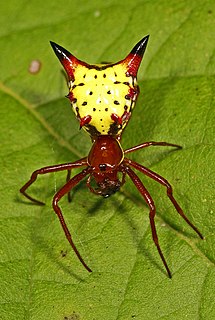
Micrathena, known as spiny orbweavers, is a genus of orb-weaver spiders first described by Carl Jakob Sundevall in 1833. Micrathena contains more than a hundred species, most of them Neotropical woodland-dwelling species. The name is derived from the Greek "micro", meaning "small", and the goddess Athena.

Gasteracantha fornicata is a species of spiny orb-weavers found in Queensland Australia. It is similar in shape to Austracantha minax which was originally described as Gasteracantha minax. It was described by Johan Christian Fabricius in 1775, the first Australian species of spider to be named and classified.

Gasteracantha cancriformis is a species of orb-weaver spider. It is widely distributed in the New World.
Molinaranea magellanica is a species of orb-weaver spider endemic to Chile, Argentina, the Juan Fernández Islands and the Falkland Islands. It is also known as the Falklands green spider. It is the largest endemic spider known to exist in the Falklands.
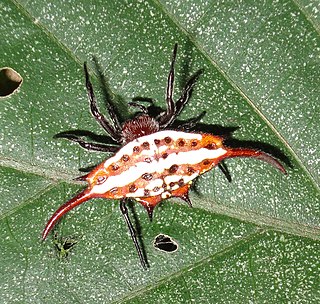
Gasteracantha versicolor, known as the long-winged kite spider, is a species of diurnal spiny orb-weaver of the family Araneidae. It is found in the tropics and sub-tropics, where it occurs in forests. It has an extensive range, from central, east and southern Africa to Madagascar.

Mastophora, also known as bolas spiders, is a genus of orb-weaver spiders first described by E. L. Holmberg in 1876. They can be identified by a pair of lumps on the dorsal surface of the opisthosoma, though not all males will have these lumps.
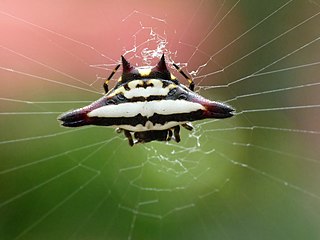
Gasteracantha geminata is a species of spider of the genus Gasteracantha, found in India and Sri Lanka. It is known as the oriental spiny orb-weaver.
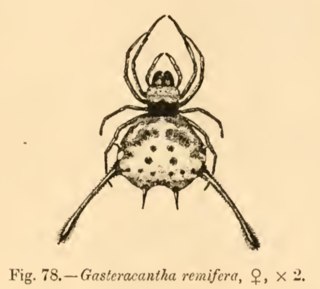
Gasteracantha remifera is a species of spiny orb-weaver spider in the genus Gasteracantha. It is found in Sri Lanka and India, and it has a pair of long, club-shaped spines on its abdomen.
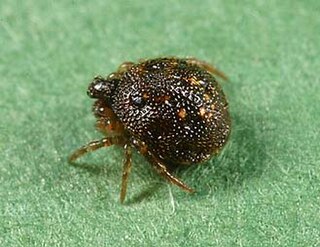
Phoroncidia is a genus of comb-footed spiders that was first described by J. O. Westwood in 1835.

Gnolus is a genus of South American orb-weaver spiders that was first described by Eugène Louis Simon in 1879. Originally placed with the orb-weaving spiders, it was transferred to the pirate spiders in 1993, but moved back to orb-weaver family in 2012.

Friula is a genus of orb-weaver spiders containing the single species, Friula wallacei. It was first described by O. Pickard-Cambridge in 1897, and has been found only on Borneo. Pickard-Cambridge based his description and drawing on a specimen collected by Alfred Russel Wallace in Sarawak between November 1854 and January 1856. Pickard-Cambridge personally confirmed with Wallace that Wallace "was the captor of this spider, and in the locality mentioned." In 2017, the Alfred Russel Wallace Memorial Fund published a call for observations of this species, stating that no specimens of the species have been collected since Wallace's and that his specimen, housed at Oxford University, is the only known specimen in the world.

Macracantha is a genus of Asian orb-weaver spiders recognized as containing a single species, Macracantha arcuata. Macracantha is notable for the extremely long, curved spines on the abdomens of female members of the genus; Eugène Simon created the taxon name from the Greek words μακρός and ἄκανθα (spine). It occurs from India and China through Southeast Asia to Borneo.
Nicolepeira is a genus of South American orb-weaver spiders first described by Herbert Walter Levi in 2001. As of April 2019 it contains only three species, all found in Chile.
Selkirkiella is a genus of South American comb-footed spiders that was first described by Lucien Berland in 1924. Originally placed with the Araneidae, it was transferred to the comb-footed spiders in 1972.

Gasteracantha westringi is a species of spiny orb-weaver spider in the genus Gasteracantha. It is found in Australasia, including New Caledonia and Norfolk Island, and it has a wing-shaped abdomen armed with red and black spines.

Gasteracantha gambeyi is a species of spiny orb-weaver spider in the genus Gasteracantha. It was described from New Caledonia.

Gasteracantha interrupta is a species of spiny orb-weaver spider in the genus Gasteracantha. It is black and white in color, and it occurs in the Lesser Sundas and Sulawesi in Indonesia.

Gasteracantha recurva is a species of spiny orb-weaver spider in the genus Gasteracantha. It was described from Manila, Philippines in 1877.
















